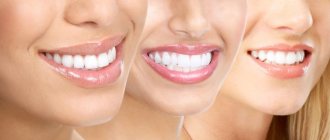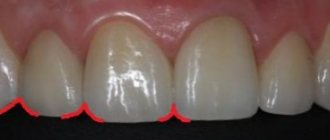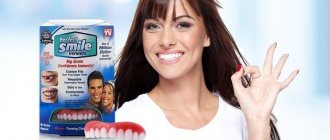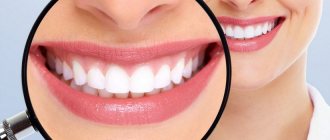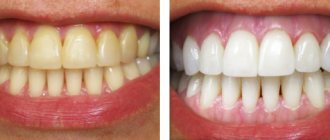Can't boast a Hollywood smile? Don't like the color of your tooth enamel? Did a tooth break and ruin your smile? There is an exit! These problems can be solved by artistic dental restoration. This is simply a magical procedure! You can restore the previous shape and color of one or several teeth at once in just one visit to the dentist.
Teeth are restored using two technologies. The first method is indirect, when ceramic plates are used to restore teeth. They are made by dental technicians in the laboratory.
The second method is direct. According to it, tooth extension occurs directly in the patient’s oral cavity. For this purpose, composite or adhesive materials are used.
Teeth renewed in this way (or regrown) are practically no different from real ones: they are just as strong, beautiful, natural and durable. However, they acquire all these qualities only if the restoration was carried out in compliance with all the necessary technological requirements inherent in a particular technique.
The cost of the procedure is pleasantly surprising, especially if you take into account its result: beautiful teeth without chips or cracks. In addition, restoration can also eliminate defects such as diastema and incorrect tooth length.
How to make white teeth yourself
There are many products available in pharmacies that guarantee complete whitening at home without the participation of dentists. In their composition, an obligatory component is hydrogen or urea peroxide, from which a large number of oxygen ions are formed, which have a whitening effect.
Whitening gels, strips, and pencils are very popular among buyers. Such products do not require special skills for application. They are practical and act quickly. They are convenient to take on trips, to work, or you can do household chores and whiten your teeth at the same time. The effect of gel products is noticeable after just a few uses. The maximum you can achieve is 3-4 tones of lightening, which will last up to a year. The most famous brands:
- Plus White
- ROCS
- Crest
Semi-professional systems for teeth whitening at home, which consist not only of peroxide gel, but also a dental tray and an activating lamp, stand somewhat separately. They are as close as possible to office methods. When used correctly, the effect is equal to 4-5 tones on the VITA scale, which lasts for one and a half years. The most used systems are Zoom and Opalescence.
«
How can you quickly whiten your teeth?
At the present stage of development, dentistry makes it possible to restore the whiteness of tooth enamel quite quickly.
When using whitening toothpastes and rinses, it may take up to several weeks or months to achieve the desired effect. Compact preparations based on hydrogen peroxide (lightening gels, pencils, plates) guarantee radiant whiteness within 7-28 days of regular use.
Home whitening systems provide noticeable results in 5-20 minutes with daily procedures for 1 week. Today, you can find products in this series on sale that promise to return a snow-white smile in just one evening.
The fastest methods are office methods. They give natural whiteness to teeth in just 1 day. In an hour spent in the dentist's chair, you can lighten the enamel by 8-12 tones at once without risk to health.
Pros and cons of types of teeth whitening
Photobleaching
- Instant results.
- Uniform impact.
- The duration of the session is no more than an hour.
- Whitening by 8 – 10 tones.
- The occurrence of tooth sensitivity during and after the procedure.
Laser whitening
- Instant results.
- No discomfort during the procedure.
- Maintaining the acid balance of the oral cavity.
- Strengthening enamel.
- Whitening by 12 tones.
- The duration of the session is more than an hour.
- Uneven teeth whitening.
- High price.
Chemical bleaching
- Instant results.
- Uniform impact.
- Acceptable price.
- Simplicity of the procedure.
- Whitening by 5 – 7 tones.
- The occurrence of tooth sensitivity during and after the procedure.
- The need for several sessions.
In-canal whitening
- Local effect on tissue.
- Painless.
- Whitening by 5 – 7 tones.
- Weakening of dental tissues.
- Prohibition on repeating the procedure.
Whitening on trays
- Affordable price.
- Possibility to use the mouth guard at any time.
- Whitening by 5 – 8 tones.
- The duration of the course is 1 month.
Lightening strips
- Visible effect after the third application.
- Affordable price.
- Whitening by 3 – 5 tones.
- Inconvenient to use.
- The duration of the course is 1 month.
Varnish or pencil
- Ease of use.
- Minimum costs.
- Lightening by 1 - 2 tones.
- Poor efficiency.
Is it possible to whiten teeth using folk remedies?
Despite all the advances in medicine, recipes for folk remedies are still popular.
- Hydrogen peroxide is an available substance sold in every pharmacy. In order to whiten teeth with its help, it is necessary to treat the enamel surface with a 3% solution after hygienic cleaning. This must be done with extreme caution, since contact of active peroxide on the gums and mucous membranes can cause burns. It is not recommended to use this method for a long time or too often, since the organic matrix of the tooth may be destroyed along with the coloring pigments.
- Baking soda is also often used for whitening. With a toothbrush moistened with a strong soda solution, simply brush your teeth as usual. You can supplement this remedy with ordinary or sea salt. The procedure cannot be repeated more than once every 7-10 days.
- Tea tree oil is also present in folk recipes. Apply a few drops of natural oil to a toothbrush and massage your teeth with it for several minutes. The manipulation is carried out after evening hygienic cleaning before bedtime. This method is well suited for maintaining the white shade of enamel. As a preventative measure, the procedure is carried out 1-2 times a week.
Whether the use of such techniques is effective is a controversial issue. Dentists are extremely skeptical about them and do not recommend getting carried away with folk remedies.
«
Causes of darkening of teeth
The condition of teeth is a reflection of nutrition, care, bad habits and other factors. If your teeth begin to darken, you need to consider a variety of reasons that could cause a change in the shade of the enamel. All the reasons why tooth enamel is darker are divided into external and internal.
External reasons
External causes mean processes occurring due to external influences on the teeth.
- Poor hygiene. Due to insufficient quality dental care, plaque remains on the enamel. Gradually, the deposits begin to compact and become more dense. If the plaque is exposed to dye, its pigment penetrates deep into the dense structure.
- Dyes. Tooth enamel weakened due to demineralization or bleaching becomes unstable to artificial and natural dyes. Changes in the color of teeth can occur with frequent consumption of foods with dyes (coffee, bright berries, vegetables and fruits, carbonated and alcoholic drinks, sweets, spices, etc.).
- Smoking. Black teeth are a common problem among smokers. The resins released when smoking a cigarette into the oral cavity are abundantly deposited on the enamel and adhere tightly to it.
Black plaque on teeth cannot be removed with a toothbrush or even whitening toothpaste. An aesthetic defect can only be eliminated using professional dental methods.
Internal reasons
External factors provoke mainly an aesthetic defect, but can cause an increased risk of dental diseases. Internal causes should be taken as seriously as possible, since they involve the impact of pathological processes on the teeth, which will only progress without appropriate treatment.
Internal factors that cause teeth to darken.
- Caries. The most common cause of darkening of tooth enamel. A distinctive feature is the change in color of one tooth. In rare cases, several adjacent teeth darken. Tooth decay can appear as a spot or cavity. If the cervical form of caries occurs, then the roots of the teeth darken, or more correctly, the root zone.
- Seal. Black teeth may be the result of fillings. Some types of composite contain substances that stain the dentin and crown. Modern dentistry does not use such materials, but if the tooth was filled more than 7-10 years ago, similar reasons cannot be ruled out.
- Metal insert. Metal is prone to oxidation, which can easily cause tooth enamel to darken.
- Metal crowns. The installation of classic metal crowns has such a defect as darkening of the tooth in the area of the marginal gum line. The appearance of blackness indicates an oxidation process, which causes the metal to be exposed to the acidic environment of the oral cavity.
- Injuries. The tooth is equipped with a large number of blood vessels, if damaged, blood can penetrate into the dentin. Due to the accumulation of blood under the crown, the process of breakdown of blood particles will affect the color of the tooth, which will change from red to blue-black.
- Depulpation. Removing the dental nerve entails many consequences. Including darkening of the enamel. The reason is a lack of nutrition to the tooth or the development of recurrent caries.
With the progression of internal causes, treatment is a mandatory step in restoring dental health and aesthetics. Depending on the pathology, the specialist determines ways to influence the pathological process.
How are teeth whitened in dentistry?
To whiten teeth in the dentist’s office, only the most modern, effective and safe techniques are used.
Almost all technologies are based on the brightening effect of reactive oxygen species released during the activation of gels based on high concentrations of hydrogen peroxide. The entire whitening process takes place under the radiation of special lamps: halogen (Beyond Polus), LED (Luma Cool) or ultraviolet (Zoom 3).
The main advantages of office methods:
- Speed of the procedure. Whitening takes no more than an hour.
- High degree of efficiency. In one session it is possible to lighten enamel up to 12 shades.
- A snow-white smile lasts up to 5-7 years with proper dental care.
- The safety of the procedure, the progress of which is constantly monitored by a doctor.
Possible inconveniences that the patient may encounter during and after whitening:
- You need to stay in the dentist's chair in one position for about an hour.
- The risk of developing increased sensitivity of tooth enamel.
- You should not drink coffee, strong tea or red wine for several days. If the patient smokes, then it is necessary to minimize the number of cigarettes or completely abandon this bad habit.
- Dentures and fillings are not subject to bleaching, so it may be necessary to replace them with others that are more consistent with the new shade.
A new word in professional whitening is laser technology. It causes minimal discomfort to the patient, since during the procedure there is no heating of dental tissues and there is no risk of burns to the mucous membranes and skin. In addition, laser radiation noticeably compacts the enamel, thereby preventing its destruction by peroxide compounds. The only drawback of the method is its high cost.
«
Types and costs
Payment in installments is possible!
| Service | Cost, rubles |
| Consultation | for free |
| Solid crown | 3 500 |
| Stump inlay (cast) | 1 500 |
| Stump tab (cast) collapsible | 1 700 |
| Metal-ceramic crown | 5 000 |
| Aesthetic restoration of the tooth crown with light-curing materials (photopolymers) | 3 000 |
| Tooth restoration (II, III class according to Black) with violation of cont. point, with destruction. hard tooth tissues by 2/3 | |
| photopolymers Filtek Ultimate | 2 700 |
| Te-Econom photopolymers | 1 350 |
| Tooth restoration (Class IV according to Black) with destruction of hard dental tissues by ½ | |
| photopolymers Filtek Ultimate | 2 500 |
| Te-Econom photopolymers | 1 300 |
| Restoration of a tooth (Class II, III according to Black) with a violation of the contact point, with destruction of the hard tissues of the tooth by ½, multi-cavity filling | |
| photopolymers Filtek Ultimate | 2 100 |
| Te-Econom photopolymers | 1 100 |
| Restoring a tooth with a filling without disturbing the contact point (Class I, V, VI according to Black) | |
| photopolymers Filtek Ultimate | 1 550 |
| Te-Econom photopolymers | 800 |
| Restoration of a tooth with a filling in violation of the contact point (Class II, III according to Black) | |
| Te-Econom photopolymers | 900 |
| photopolymers Filtek Ultimate | 1 700 |
| Tooth restoration with filling (IV class according to Black) | |
| photopolymers Filtek Ultimate | 2 000 |
| Te-Econom photopolymers | 1 000 |
Is it possible to whiten artificial teeth?
Often patients who have ceramic or plastic dentures are interested in what will happen to them after the whitening procedure and is it possible to change their color? Unfortunately, metal-ceramic and other artificial teeth cannot be lightened using conventional methods, since hydrogen peroxide only affects organic compounds. Therefore, dentists recommend carrying out whitening procedures before dentures. Otherwise, such designs will require replacement with the selection of a new shade.
Extensions or teeth with fillings should not be bleached because they are also not exposed to bleach. If the patient decides to lighten the teeth, then he is advised to install new fillings, especially if they are located on the visible part of the dentition.
Wearing a night guard
Sometimes your doctor may prescribe a night guard. If you have bruxism (teeth grinding due to too much clenching of the jaw and involuntary contraction of the chewing muscles), then in order not to damage the restoration during sleep, you need a mouthguard. It is made individually for you and therefore you will not feel any inconvenience with it. But remember, a mouth guard is a dental protection, not a treatment for bruxism. Therefore, if you have such a problem, it requires a solution and contacting specialists.
We provide a guarantee for dental restoration. But it has been noted that if the patient strictly follows all our recommendations, then the restorations will safely serve for 7 years or more. Agree, such a smile is worth the effort!
What is the best way to save a pulpless “dead” tooth?
There is a special intracanal technology for whitening pulpless teeth. During internal whitening, a peroxide solution is injected into the tooth cavity, after which a temporary filling is applied. When you visit the dentist again, it is determined how well the new shade matches the color of the remaining teeth. If the result is satisfactory, the remaining solution is washed away and a permanent filling is placed.
Another possible method is external whitening by applying the gel to only one single tooth. In this case, you can also use home remedies.
What is the best way to whiten teeth after smoking?
Smokers often have unsightly yellow teeth. Fangs are especially susceptible to this addiction, since the maximum dose of nicotine falls on them.
In order to whiten your teeth after smoking, it is recommended to use a special tooth powder to brush your teeth. It has good abrasive properties and is able to remove even heavy plaque from the tooth surface. But such cleaning should be carried out no more than once a week, since there is a possibility of damage to the enamel.
For regular oral hygiene and to maintain whiteness, it is advisable to use special toothpastes that contain enzymes that help break down plaque. These pastes include:
- ROCS "Antitobacco"
- Rembrandt "Antitobacco"
- Dentavit for smokers
- ASTERA for smokers
If a smoker plans to carry out whitening using in-office techniques, then a few days before the procedure it is necessary to have professional teeth cleaning. This will help more active and uniform lightening.
Types of professional teeth whitening
Reviews about types of teeth whitening on the Internet make many patients believe in the myth about the effectiveness of hydrogen peroxide purchased at the pharmacy, soda, activated carbon and other simple methods. Following such dubious advice is not only pointless, but also fraught with dangerous consequences - burns of the oral cavity, damage to the enamel and increased sensitivity of the teeth. In fact, there are only two types of professional whitening – in-office and at-home.
What is the best way to whiten tetracycline teeth?
When taking some antibiotics from the tetracycline group, a person may change the color of tooth enamel. It becomes dirty yellow, brown or dark gray. This is especially noticeable when treated with such drugs in childhood during the formation of teeth.
Tetracycline teeth are extremely difficult to whiten because the pigmentation is deep. In this case, folk remedies and home methods will not be effective. Only professional whitening techniques in a dental office can help. Often several procedures are required in succession.
How to whiten teeth under braces?
Improper care and drinking coffee or strong tea in large quantities lead to the fact that teeth in braces acquire an unsightly yellowish tint. But in such cases, enamel whitening cannot be carried out until the orthodontic bracket system is removed. Lightening gels do not penetrate under the structural elements and as a result, dark spots form on the surface of the teeth. In addition, people who wear braces have teeth that are more susceptible to decay. Therefore, you should wait a bit with the whitening procedure.
The only option in such situations is to regularly visit the hygienist's office for professional cleaning. This procedure will not change the natural shade of the teeth, but will get rid of the unsightly yellow plaque and give your smile a natural beauty.
How do stars whiten their teeth?
Celebrities spend many tens of thousands of dollars on their snow-white smiles. After all, the overall appearance and potential success depend on them. Therefore, such people do not skimp on the dentist and do not use questionable techniques. To achieve radiant whiteness, stars trust only modern professional techniques: Zoom 3, Luma Cool, laser whitening. But they are not limited to the lightening procedure. To maintain the achieved shade, periodic professional cleaning of the enamel is carried out, and special proven toothpastes are used for everyday care.
In order for your smile to be as radiant as that of the stars, you should not experiment with whitening agents. It is better to contact a good specialist who will assess the condition of the oral cavity and give a personal recommendation as to which remedy will be optimal for your particular situation. When carrying out the procedure at home, you must strictly follow the instructions and not violate the whitening technology. Only in this case can you count on success without negative health consequences.
